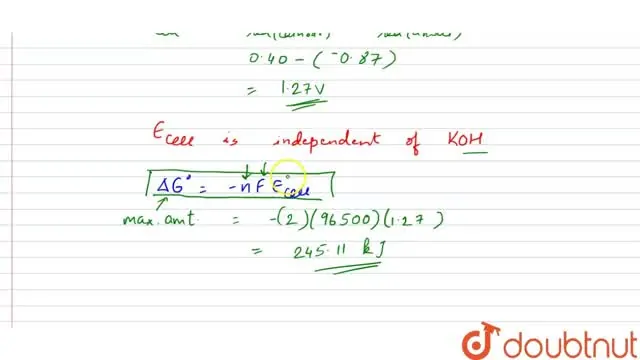The Edison storage cell is represented as :
Fe(s)|FeO(s)|KOH(aq)|Ni2O3(s)|Ni(s)
The half− cell reactions are :

a. What is the cell reaction ?
b. What is the cell EMF ? How does it depend on the concentration of KOH ?
c. What is maximum amount of electrical energy that can be obtained from 1mol of Ni2O3 ?
The correct Answer is:b.1.27V,c.245.11kJ
Given that,
Ec−.FeO∣Fe=−0.87V and Ec−.Ni2O3∣NiO=+0.40V
In these electrodes, Ec− of FeO∣Fe is greater than that of Ni2O3∣NiO.
So, following reactions are possible at anode and cathode :
At anode :
Fe(s)+2c−OH(l)→FeO(s)+H2O(l)+2e− Ec−=+0.87V
At cathode:
Ni2O3(s)+H2O(l)+2e−→2NiO(s)+2c−OH(l),,,,,,Ec−=+0.40V
a. Hence, cell reaction
Fe(s)+Ni2O3→FeO(s)+2NiO(s)
b.EMF of the cell =Ec−.cathode−Ec−.anode
=Ec−.Ni2O3∣NiO−Ec−.FeO∣Fe
=0.40−(−0.87)=+1.27V
This EMF is not based upon the concentration of KOH.
c. Produced electrical energy with one mole of
Ni2O3=n×Ec−.cell×F
=2×1.27×96500J
=245.11kJ
Related Playlists
- BOOK - CENGAGE CHEMISTRY ENGLISHCHAPTER - ELECTROCHEMISTRYEXERCISE - Archieves True/False1videos
ELECTROCHEMISTRY
- BOOK - CENGAGE CHEMISTRY ENGLISHCHAPTER - D AND F BLOCK ELEMENTSEXERCISE - Archives Subjective29videos
D AND F BLOCK ELEMENTS
- BOOK - CENGAGE CHEMISTRY ENGLISHCHAPTER - GENERAL PRINCIPLES AND PROCESS OF ISOLATION OF ELEMENTSEXERCISE - Archives (Subjective)14videos
GENERAL PRINCIPLES AND PROCESS OF ISOLATION OF ELEMENTS
Similar Questions
For a cell Ag(s)|AgNO3(0.01M)||AgNO3(1.0M)|Ag(s)
(i). Calculate the e.m.f. of the cell at 25∘C
(ii). Write the net cell reaction.
(iii). Will the cell generate e.m.f when two concentrations become equal?View SolutionE∘ for the cell
Zn(s)∣∣Zn2+(aq)∣∣Cu2+(aq)∣Cu(s) is 1.1V at 25∘C the equilibrium constant for the cell reaction is aboutView SolutionA hypothetical electrochemical cell is shown below
ΘPt(s)|A2(1atm)|A−(xM)∣∣∣B+(yM)∣∣B(s)⊕
The emf measured is 0.30V The cell reaction is :-View SolutionThe electrochemical cell representing the given reaction
Ni(s)+Cu2+→Ni2++Cu(s)View SolutionEmf of cell given
Ag(s),Ag(s)|KCI(aq)Hg2CI2(s)|Hg(s)
s 0.05 V at 300 K and temperature coefficient of the cell is 3.34×10−4VK−1 calculate the change in thapy of the cellView SolutionThe standard potential of a cell using the reaction
 +3HgO(s)+2(c−OH)(aq) is 0.489V at 25∘C. What is the equilibrium constant of the reaction ?View Solution
+3HgO(s)+2(c−OH)(aq) is 0.489V at 25∘C. What is the equilibrium constant of the reaction ?View SolutionThe standard emf for the cell reaction,
2Cu+(aq)→Cu(s)+Cu2+(aq)
is 0.36V at 298K. The equilibrium constant of the reaction isView SolutionThe standerd free energy change for the following reaction is -210kJ/mol. What is the standerd cell potential? 2H2O2(aq)→2H2O(l)+O2(g)
View SolutionThe emf of the cell reaction
Zn(s)+Cu2+(aq)→Zn2+(aQ)+Cu(s)
is 1.1V. Calculate the free enegry change for the reaction. If the enthalpy of the reaction is −216.7kJmol−1, calculate the entropy change for the reaction.View SolutionThe cell reaction of a cell is as follows: Mg(s)+Cu(aq)2+→Cu(s)+Mg(aq)2+ . If the standard reduction potentials of Mg and Cu are −2.37 V and +0.34 V respectively, the e.m.f. (in V) of the cell is:
View Solution


